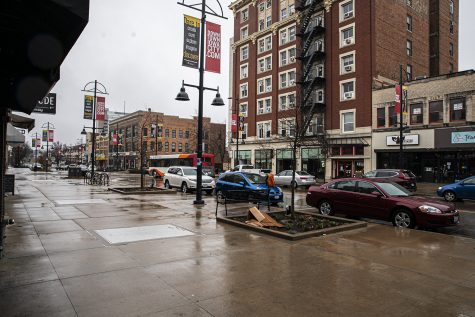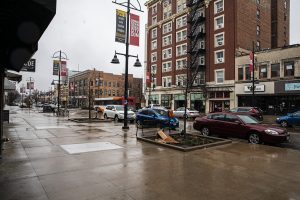Opinion: Crohn’s, COVID-19, and the current crisis
Before the pandemic, my immune system was suppressed to keep me healthy, but now it could put me at serious risk.
March 22, 2020
I lay awake in bed at 1:30 a.m. March 18, focused on the tightness in my chest, my hands and lips tingling. My breathing was labored, my mind was racing. I couldn’t tell if the physical state I experienced was out of anxiety or out of true illness. I decided to visit my doctor in the morning.
It had begun on March 14, a cough and sore throat, chills along with little appetite. All symptoms came off and on through the weekend, carrying into the early part of the next week. The morning of March 17 brought stomach pain and no appetite.
For most 21-year-olds, contracting illness doesn’t warrant much concern, but for someone who takes immunosuppressants, it becomes more serious. With the spread of COVID-19, immunosuppressed individuals face the possibility of complications requiring hospitalization and the threat of death as the body is left with few resources to fight.
I was diagnosed with Crohn’s disease, a digestive illness, during my sophomore year of high school. Inflammatory Bowel Diseases occur when the body’s immune system works in overdrive to protect the digestive system, resulting in tissue damage. For some, Inflammatory Bowel Disease only affects small portions of the digestive tract, but for those with Crohn’s, it impacts the entire tract.
The only cure for the illness is routine immunosuppressant medication, meant to weaken the immune system’s response on the gut, which in turn weakens the immune system entirely. This does not make a person more susceptible to contracting a virus, but creates complications, sometimes severe, when a virus is contracted.
Contacting my doctor, I thought the underlying cause was a flare up of my Crohn’s symptoms. After reviewing my symptoms, she became concerned and decided I should contact UIHC’s unit working on COVID-19 cases.
For most 21-year-olds, contracting illness shouldn’t be much concern, but for someone who takes immunosuppressants, it becomes more serious.
After a night of little rest, I contacted a hotline and was connected with a nurse, who talked through the symptoms and the concerns I had with the immunosuppressant medication I took. After a five-minute conversation, the nurse concluded and said a doctor would call in awhile. An hour later, I was on the phone with a doctor, who explained that given my symptoms and my state of medication, they wanted me to come in.
When I arrived at the hospital, security guards stood inside the entrances, with hospital staff in face masks and protective visors 20 feet behind. I walked down the hall and was asked if I had experienced a cough, fever, or shortness of breath recently. After saying yes, I was asked to put on a mask. After confirming my appointment with the staff and getting a name tag, I then moved toward the family medicine clinic, where those suspected of having the virus were sent.
I made my way through the winding halls of the hospital, and finally found the entrance to the clinic. The door opened and a security guard watched the front door as I entered. The front desk had a plastic shield surrounding it, acting as a barrier to the three hospital faculty working behind it. Most of the workers in the unit were dressed in protective covering with plastic covers over their faces, gloves, and protective garments over the scrubs.
After checking in, a young nurse dressed in full protective garb eventually called my name. I stepped toward a hallway full of people in protective equipment. I was unnerved at how strange it felt to be in my current situation. To feel so out of place as others looked on behind protective measures, to know that I was the center of attention, but not necessarily in a positive way, was abstract. After going through basic vitals, I was left in a room to await a doctor.
I sat in silence for a few minutes. The room was standard for something you would see upon a regular check up, except wipes and cleaning supplies were readily available to wipe down any surface that came into contact with me.
The inability to have the test means that millions of other Americans with less-than-ideal immune systems must wait for testing until severe situations, opening up the anxiety of the uncertain future.
The doctor entered the room, sitting at a chair four feet away, decked in visor, cloves, and a mask. She introduced herself and we began to talk about my symptoms. After checking the vital readings and listening to my lungs, she concluded that I did not meet the criteria to be tested. She explained that the main focus of testing at the moment was those who knowingly came into contact with a person who had the virus, or those above the age of 60 with symptoms. She added that she suspected I probably had another bug of some sort.
She led me out of the room and took me back to the waiting room while I waited to have my blood tested. After 15 minutes, I was led into another standard room of the clinic, where blood samples were drawn, which would serve as an indicator to what might be occurring within my body. The nurse took three tubes of samples, and I was free to leave. All I was asked to do was self-isolate for the next 14 days.
When I left the hospital, I felt both relieved and concerned. I was relieved to have seen a medical professional, to be told that my symptoms most likely indicated another bug. At the same time, I was concerned about what the next weeks would have in store for me.
Even with the judgment of the medical staff at a well-regarded institution, I still did not have the assurance of a test. The anxiety I felt crept in, and the “what ifs” took hold. While still an active, healthy young person, I knew that contracting the virus could have serious complications such as pneumonia. An infection wouldn’t be easily fought off as the immune suppressants meant to keep me healthy would not let my body fight back as hard as I would want it to.
The inability to have the test means that millions of other Americans with less-than-ideal immune systems must wait for testing until severe situations, opening up the anxiety of the uncertain future. Numerous reports show the U.S. has conducted the lowest number of COVID-19 tests per capita of any country in the world affected by the spreading pandemic.
The expansive testing medical experts recommend as the best way to evaluate the current pandemic remains low.
According to a report by The Washington Post, doctors in parts of New York City — one of the worst-affected regions in the United States — were unable to test patients suspected of having the virus because of strict testing criteria. Those who presented symptoms were not given the test because of the rationing of test kits available, similar to what I experienced. Health-care workers, some of the most susceptible to contracting COVID-19, have not received routine testing.
As the number of health-care workers who fall ill increases, the capacity of the health-care system decreases, meaning less ability to treat the scores of patients requiring medical attention. As of Sunday night, 15,168 cases of the virus were confirmed in New York alone.
In efforts to boost testing capabilities, the White House has asked several commercial companies, including Fed-Ex, to use aircraft in order to ship medical supplies needed for virus-stricken regions. While the private sector offers supplies and resources, the expansive testing medical experts recommend as the best way to evaluate the current pandemic remains low.
For the state of Iowa, testing parameters remain strict. The Iowa Department of Public Health’s criteria for testing includes:
• All hospitalized patients with fever and respiratory failure and no alternate diagnosis
• Adults ages 60 or older with fever and respiratory symptoms (cough, difficulty breathing) and chronic medical conditions (e.g., diabetes, heart disease, immunosuppressive medications, chronic lung disease, or chronic kidney disease)
• Persons with fever or respiratory illness who live in congregate setting (i.e., long-term care facilities, dormitories, residential facilities, correctional facilities, treatment facilities)
• Essential services personnel with fever or respiratory illness (i.e., health-care providers, fire and EMS, law enforcement, residential-facility staff)
As of Sunday night, the number of Iowa COVID-19 cases reported by the Iowa Department of Public Health — which uses the Iowa City-based State Hygienic Lab — marked 90. Because of limited testing and substantial evidence of community-acquired transmission of the virus in Iowa, it’s unknown what the actual scope of the virus’ spread is, which experts say makes it more difficult to treat and to further contain its spread.
Columns reflect the opinions of the authors and are not necessarily those of the Editorial Board, The Daily Iowan, or other organizations in which the author may be involved.





















